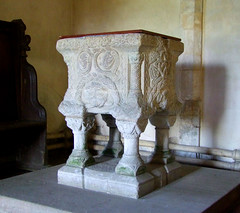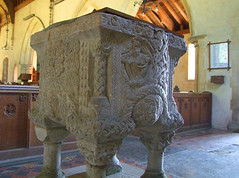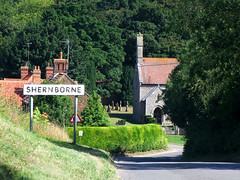| |
|
St Peter
and St Paul, Shernborne
 |
|
It
was a beautiful morning in early August. I had
taken my bike on the train to Kings Lynn, and by
half past ten I had already visited the churches
in Castle Rising, Babingley, West Newton,
Sandringham and Dersingham. And yet, as lovely as
the morning was, there was still that heaviness
which seems to sit over the whole King's Lynn
area, a creeping malaise which perhaps drifts in
from the marshland, settling over the town and
the forests which spread around the Sandringham
estate. It weighs you down - or, at least, it
does me. And then I cycled up the steep hill out
of Dersingham towards sunshine, into the hedged
lanes through the rolling ridges and copses, and
I knew I was free. It was the
height of the barley harvest. Busy tractors
hauled trailers piled high with the golden
berries at impossible speeds through the lanes.
It was best to stop, and let them pass. At the
top of the ridge I could see for miles, and I
could see a little village with a towerless
church in the valley below, so I freewheeled down
towards it.
|
There's
not much to Sherborne beyond the little church and some
pretty cottages. Huddled in its valley as it is, you
could spend an awful lot of time in Norfolk without
realising it existed. The church was one of those rebuilt
as part of the grand scheme of the Prince of Wales, later
Edward VII, to improve the villages around the
Sandringham estate. This area was one of the poorest in
England by the late 19th Century, and the extent to which
the purchase of the Sandringham estate by the future King
changed west Norfolk forever is not always realised. The
architect here was Herbert Green, from the Diocese, not
one of the late 19th Century's more creative
imaginations. Mortlock points out that Sir Reginald
Blomfield was 'consulted' - at the time, Blomfield, a
favourite architect of the Royals, was working on
Sandringham church, and one likes to imagine the Prince
going up to the building site and enquiring
confidentially of him, 'this Green chap - d'ye think he's
up to the job?'
Ironically,
church historians have a bit of a downer on Green because
of his passion for neo-Norman, which he resisted here at
Shernborne, but it is an enthusiasm which may have caused
him to treat its most significant feature with the utmost
respect. There are a group of about twenty Norman fonts
in the north-west corner of Norfolk which are considered
among the finest in the kingdom, and Shernborne font is
the best of them.
  
If
somebody produced the Sherborne font today we'd think it
was pretty amazing. That it was carved almost a thousand
years ago, and has been here ever since, is staggering.
The key design feature is the use of plaited knotwork
which trails around the font almost like foliage. All
four sides are different. Faces peer out, figures in
roundels strike mystifying attitudes. It is remarkable.
A
heartbreaking brass plaque on the nave wall is to Robert
and Charles Pitcher, two brothers killed in the First
World War. What makes it so sad is that they were both
killed on the same day, 19th April 1917, in the Battle of
Gaza. How does a parent ever get over something like that
happening?
| There's
no coloured glass in the nave windows, but even
so you can't help thinking that this must be
rather a gloomy place in winter. Not much light
makes it through the low arcade from the south
aisle. As if to brighten the place up a bit, an
east window by Hardman & Co was installed in
the 1920s, and it is rather good. It depicts
Christ as the Good Shepherd flanked by St Peter
and St Paul, the patrons of the church. Below, we
see Peter letting down his nets and Paul rather
pleasingly as a tent-maker. Christ asking that
the children be suffered to come unto him
completes the sequence. The font is
not the only survival from the earlier church,
for up in the chancel is a large 15th Century
brass to Thomas Shernborne and his wife. It is
mounted on the north wall, from which it will run
away like so much butter if there is ever a fire
here. Brasses should really be mounted on floors,
so the heat rises above them. Thomas Shernborne
was Chamberlain to Margaret of Anjou, an
extraordinary thought in this tiny little
backwater, tucked away from the rest of the
world.
|
|
 |
|
|
|
